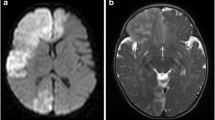Summary
We evaluated and analysed our own 31 cases of the haemorrhagic type of moyamoya disease to clarify the clinical features of this disease. The cases were divided into three groups. Group A consisted of 12 cases with aneurysms. Aneurysms on the circle of Willis were treated as ordinary saccular aneurysms. Group B consisted of 14 cases with intracerebral haemorrhage (ICH) without aneurysms. These were managed almost as spontaneous ICH. Group C consisted of 5 cases with intraventricular haemorrhage (IVH) without aneurysms or ICH. Twenty-two surgical procedures for aneurysms, ICH and IVH were done in 19 cases (62%). Nineteen procedures for preventing future strokes were undertaken in 11 cases (35%). The overall initial outcome was excellent in 12 cases (39%), good in 7 cases (23%), poor in 7 cases (23%), and death in 5 cases (15%). During the follow-up period (mean: 6.5 years), rebleeding occurred in two cases (8%), and ischaemic attacks in two cases (8%). The rate of rebleeding or ischaemic attacks was 1.19% per patient-year during the follow-up period. There was no ischaemic or rebleeding episode in cases treated by STA-MCA bypass with encephalomyosynagiosis (EMS) during the follow-up period. Management of the primary haemorrhage should be according to the clinical condition, type of haemorrhage, and source of haemorrhage. When the patient needs to undergo revascularization surgery to prevent future strokes, we recommend STA-MCA bypass with EMS instead of encephaloduro-arteriosynangiosis (EDAS).
Similar content being viewed by others
References
Ando T, Iwai T, Shimizu K, Mwa Y, Deguchi K, Sakai N, Yamada H, Ohkuma A, Hunakoshi T (1988) Moyamoya disease associated with aneurysm. Analysis of six cases. Surg Cereb Stroke 16: 161–167 (Jpn)
Aoki N (1993) Cerebrovascular bypass surgery for the treatment of moyamoya disease: unsatisfactory outcome in the patients presenting with intracranial hemorrhage. Surg Neurol 40: 372–377
Fujitsu K, Muramoto M, Ikeda Y, Inada Y, Kim I, Kuwabara T (1990) Indication of putaminal hemorrhage. Comparative study based on serial CT and time-course analysis. J Neurosurg 73: 518–525
Grabel JC, Levine M, Hollis P, Ragland R (1989) Moyamoyalike disease associated with a lenticulostriate region aneurysm. Case report. J Neurosurg 70: 802–803
Hamada J, Hashimoto N, Tsukahara T (1994) Moyamoya disease with repeated intraventricular hemorrhage due to aneurysm rupture. Report of two cases. J Neurosurg 80: 328–331
Ikezaki K, Matsushima T, Kuwabara Y, Suzuki SO, Nomura T, Fukui Y (1994) Cerebral circulation and oxygen metabolism in childhood moyamoya disease: a perioperative positron emission tomography study. J Neurosurg 81: 843–850
Imielinski BL, Kloc W (1993) Spontaneous intracerebral hematomas: clinical appraisal of surgical and conservative treatment. In: Lorenz R, Klinger M, Brock M (eds) Advances in neurosurgery 21. Springer, Berlin Heidelberg New York Tokyo, pp 5–11
Karasawa J, Kikuchi H, Furuse S, Kawarura J, Sakaki Y (1987) Treatment of moyamoya disease with STA-MCA anastomosis. J Neurosurg 49: 679–688
Karasawa J, Touho H, Ohnishi H, Miyamoto S, Kikuchi H (1992) Long-term follow-up study after extracranial-intracranial bypass surgery for anterior circulation ischaemia in child-hood moyamoya disease. J Neurosurg 77: 84–89
Krayenbühl HA (1975) The moyamoya syndrome and the neurosurgeon. Surg Neurol 4: 353–360
Nakai H, Yamamoto K, Sako K, Tanikawa R, Kunimoto M, Hashimoto M, Tomabechi M, Ohgami S, Yonemasu Y, Muraoka S (1992) A ruptured aneurysm at the peripheral collateral circulation of the anterior choroidal artery in a patient with moyamoya disease: a case report. Neurol Surg 20: 985–990 (Jpn)
Nishimoto A (1979) Moyamoya disease. Neurol Med Chir 19: 221–228 (Jpn)
Onda H, Kagawa M, Wanifuchi H, Aoki N, Takeshita M, Ujiie H, Izawa M, Kitamura K (1988) Five cases of moyamoya disease with intracranial aneurysms. Surg Cereb Stroke 16: 168–174 (Jpn)
Pool JL, Wood EH, Maki Y (1967) On the cases with abnormal vascular network in the cerebral basal region in the United States. In: Kudo T (ed) A disease with abnormal intracranial vascular networks. Spontaneous occlusion of the circle of Willis. Igaku Shoin, Tokyo, pp 63–68
Sundt TM Jr (1990) Results of surgical management. In: Sundt TM Jr (ed) Surgical techniques for saccular and giant intracranial aneurysms. Williams and Wilkins, Baltimore, pp 19–23
Suzuki J, Takaku A (1969) Cerebrovascular “Moyamoya“ disease. Disease showing abnormal net-like vessels in base of brain. Arch Neurol 20: 288–299
Ueki K, Meyer F, Mellinger JF (1994) Moyamoya disease: the disorder and surgical treatment. Mayo Clin Proc 69: 749–757
Wanifuchi H, Takeshita M, Izawa M, Aoki N, Kagawa M (1993) Management of adult moyamoya disease. Neurol Med Chir (Tokyo) 33: 300–305
Yabumoto M, Funahashi K, Fujii T, Hayashi S, Komai N (1983) Moyamoya disease associated with intracranial aneurysms. Surg Neurol 20: 20–24
Yamashita M, Tanaka K, Matsuo T, Yokoyama K, Fujii T, Sakamoto H (1983) Cerebral dissecting aneurysms in patients with moyamoya disease. J Neurosurg 58: 120–125
Yasargil MG (1984) Clinical considerations. In: Yasargil MG (ed) Microneurosurgery II. Clinical considerations. Surgery of the intracranial aneurysms and results. Thieme, Stuttgart, pp 1–32
Author information
Authors and Affiliations
Rights and permissions
About this article
Cite this article
Kawaguchi, S., Sakaki, T., Kakizaki, T. et al. Clinical features of the haemorrhage type moyamoya disease based on 31 cases. Acta neurochir 138, 1200–1210 (1996). https://doi.org/10.1007/BF01809751
Issue Date:
DOI: https://doi.org/10.1007/BF01809751




